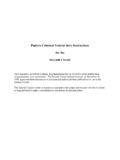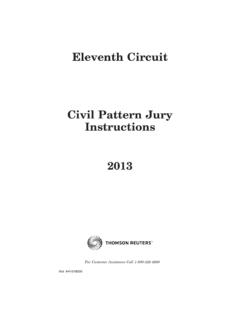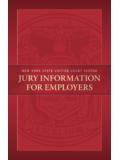Transcription of Ninth Circuit Jury Instructions - Admiralty
1 INTRODUCTORY COMMENT. These Instructions were prepared for use in an action brought under maritime common law and the Jones Act, 46 688, by a "seaman" against his or her employer. The Instructions focus on the issues of negligence, contributory negligence, unseaworthiness, and maintenance and cure. They assume that the plaintiff was injured while in the course of employment as a crew member of a vessel. Definitional sections for "crew member," "vessel," "in the course of employment," and "in the service of the vessel" have not been included because of the infinite variety of situations that arise. For assistance in dealing with these terms, it is preferable to refer to cases with fact patterns similar to the case under consideration. See, , Southwest Marine, Inc. v. Gizoni, 502 81. (1991) (discussing "crew member," and "vessel"); Kathriner v. UNISEA, Inc., 975 657 (9th ) (discussing "vessel in navigation").
2 In order to recover under the Jones Act, or under the doctrine of unseaworthiness, the plaintiff must be a "seaman." A new instruction on seaman status has been included. See Instruction (Seaman Status). SEAMAN STATUS. The plaintiff seeks recovery against the defendant under the Jones Act [and the doctrine of unseaworthiness]. Only a "seaman" can bring these claims. The parties dispute whether or not the plaintiff was a seaman at the time of his injury. The plaintiff must prove that the plaintiff was a "seaman" in order to recover. To prove seaman status, the plaintiff must prove both of the following elements by a preponderance of the evidence: 1. the vessel on which the plaintiff was employed was in navigation and the capacity in which the plaintiff was employed contributed to the vessel's mission or to the operation or maintenance of the vessel under way or while at anchor or tied up in preparation for future trips.
3 A person need not aid in the navigation of a vessel in order to qualify as a seaman; and 2. the plaintiff had a more or less permanent connection with the vessel which was substantial in terms of time and work, rather than sporadic, temporary, or incidental. Comment See Harbor Tug & Barge Company v. Papai, 520 548, 554 (1997); Chandris, Inc. v. Latsis, 515 347, 355 (1995); Gizoni v. Southwest Marine Inc., 56 1138, 1141 (9th ) (two elements of test discussed). The seaman inquiry is a mixed question of law and fact, and when necessary, should be submitted to the jury . Delange v. Dutra Construction Co., 183 916, 919 (9th ). A plaintiff may be entitled to an instruction on the fleet seaman doctrine if it has some foundation in the evidence. Gizoni, 56 at 1141 ("Under the fleet doctrine, one can acquire 'seaman status' through permanent assignment to a group of vessels under common ownership or control.)
4 "). The Longshore and Harbor Workers' Compensation Act (LHWCA) excludes from its coverage "a master or member of a crew of any vessel." 33 902(3)(G). Masters and crew members are entitled to sue under the Jones Act and the doctrine of unseaworthiness. A. non-"seaman" is limited to the remedies of the LHWCA. JONES ACT NEGLIGENCE CLAIM . ELEMENTS AND BURDEN OF PROOF (46 APP. 688). On the plaintiff's Jones Act claim, the plaintiff has the burden of proving both of the following elements by a preponderance of the evidence: 1. the defendant was negligent as claimed; and 2. the defendant's negligence was a cause of the injury to the plaintiff. If you find that both of the elements on which the plaintiff has the burden of proof have been proved, your verdict should be for the plaintiff. If, on the other hand, the plaintiff has failed to prove either of these elements, your verdict should be for the defendant.
5 Comment For a discussion of the elements of a Jones Act negligence claim, see In re Hechinger, 890. 202, 208 (9th ) ("To recover under a Jones Act claim, a plaintiff has the burden of establishing by a preponderance of the evidence, negligence on the part of his employer .. [and]. that the act of negligence was a cause, however slight, of his injuries." (quotations and citation omitted)), cert. denied, 498 848 (1990). Cf. Mohn v. Marla Marie, Inc., 625 900 (9th ). JONES ACT NEGLIGENCE DEFINED. Negligence is the failure to use reasonable care. Reasonable care is the degree of care that reasonably prudent persons would use under like circumstances to avoid injury to themselves or others. Negligence is the doing of something that a reasonably prudent person would not do, or the failure to do something that a reasonably prudent person would do, under like circumstances. JONES ACT NEGLIGENCE CLAIM CAUSATION.
6 Negligence is a cause of an injury or damage if it played any part, no matter how small, in bringing about the injury or damage. Therefore, even if the negligence operated in combination with the acts of another, or in combination with some other cause, the negligence was a cause of the injury or damage if it played any part, no matter how small, in bringing about the injury or damage. Comment See Ribitzki v. Canmar Reading & Bates, Ltd. Partnership, 111 658, 662 (9th ) ("even the slightest negligence" is sufficient to support a Jones Act finding of negligence) (citing Havens v. F/T Polar Mist, 996 215, 218 (9th )). This test is often described as a "featherweight causation standard" and allows a seaman to survive summary judgment by presenting even the slightest proof of causation. Ribitzki, 111 at 664. The requirement of cause for the plaintiff's negligence claim is different from that for the unseaworthiness claim.
7 Where negligence and unseaworthiness are both claimed, it may be advisable to compare the causal requirements for each. See Lies v. Farrell Lines, 641 765, 769 (9th ). JONES ACT PLAINTIFF'S COMPLIANCE WITH. DEFENDANT'S REQUEST OR DIRECTIONS. The plaintiff is not negligent simply because the plaintiff, upon the request or direction of the defendant, worked at a dangerous job, or in a dangerous place, or under dangerous conditions. Comment Use this instruction only where the plaintiff's compliance with an employer's request or direction is an issue. Under the "primary duty" doctrine, "a seaman-employee may not recover from his employer for injuries caused by his own failure to perform a duty imposed on him by his employment." California Home Brands, Inc. v. Ferreira, 871 830, 836 (9th ). The primary duty rule is not applicable "where a seaman is injured by a dangerous condition that he did not create and, in the proper exercise of his employment duties, could not have controlled or eliminated.
8 " See Bernard v. Maersk Lines, Ltd., 22 903, 907 (9th ). A seaman who follows a supervisor's urgent call to the crew for help cannot be found contributorily negligent. Simenoff v. Hiner, 249 883, 890 91 (9th ). UNSEAWORTHINESS CLAIM ELEMENTS AND BURDEN OF PROOF. On the plaintiff's unseaworthiness claim, the plaintiff has the burden of proving both of the following elements by a preponderance of the evidence: 1. the [name of vessel] was unseaworthy; and 2. the unseaworthy condition was a cause of an injury to the plaintiff. If you find that both of the elements on which the plaintiff has the burden of proof have been proved, your verdict should be for the plaintiff. If, on the other hand, the plaintiff has failed to prove either of these elements, your verdict should be for the defendant. Comment "A shipowner has an absolute duty to furnish a seaworthy ship." Mitchell v. Trawler Racer, Inc.
9 , 362 539, 549 (1960). A seaworthy ship is one reasonably fit for its intended use. Ribitzki v. Canmar Reading & Bates, Ltd. Partnership, 111 658 (9th ). See also Comment to Instruction (Unseaworthiness Defined). UNSEAWORTHINESS DEFINED. A vessel owner has a duty to provide and maintain a seaworthy vessel. [That duty cannot be turned over to anyone else.]. A vessel is seaworthy if the vessel and all of its parts and equipment are reasonably fit for their intended purpose [and it is operated by a crew reasonably adequate and competent for the work assigned]. A vessel is unseaworthy if the vessel, or any of its parts or equipment, is not reasonably fit for its intended purpose [or if its crew is not reasonably adequate or competent to perform the work assigned]. A vessel owner has a duty to provide adequate safety equipment for the vessel. However, the owner of the vessel is not required to furnish an accident-free ship.
10 A vessel owner is not called on to have the best parts and equipment, or the finest of crews, but is required to have what is reasonably proper and suitable for its intended use, and a crew that is reasonably competent and adequate. Comment For a definition of a seaworthy vessel, see Ribitzki v. Canmar Reading & Bates, Ltd. Partnership, 111 658, 664 (9th ) and Havens v. F/T Polar Mist, 996 215, 217 8. (9th ). A shipowner has the duty to a seaman employed on the ship to furnish a vessel and appurtenances which are reasonably fit for their use. This includes maintaining a ship's equipment in proper operating condition. The failure of a piece of equipment under proper and expected use is sufficient to establish unseaworthiness. Lee v. Pacific Far E. Line, 566 65, 67 (9th ). But see Mitchell v. Trawler Racer, 362 539, 550 (1960) (no obligation to furnish accident-free ship). A vessel may be unseaworthy because of "defective" crew members.








